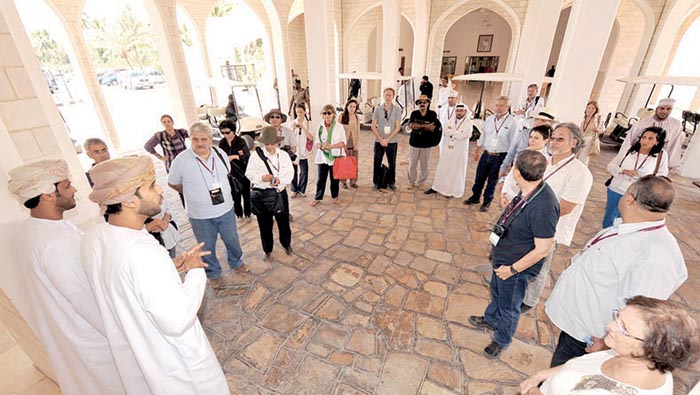
Salalah: Frankincense Land Museum at Al Baleed Archaeological Park affiliated to the Office of His Majesty the Sultan’s Advisor for Cultural Affairs is one of the prominent cultural landmarks and distinctive examples of the museums available at the archaeological parks listed on the World Heritage List.
The Frankincense Land Museum is situated on the coastal strip of Salalah, about 5 km from the city centre.
The museum is a comprehensive view of the Sultanate, its various governorates, its time periods and an opportunity to learn about its historic and maritime heritage.
The Frankincense Land Museum provides visitors and researchers with a summary on the country’s march and an opportunity to familiarise with its long historic and maritime heritage, as well as examples of archeological evidence through the ages to the present time through two halls; the History Hall, which is a window on many cultural and archaeological sites that contains six sections, namely the Geography of Oman, Oman in Ancient Times, the Land of Frankincense, Islamisation of the People of Oman, Chapters of Omani History, and the Renaissance of Oman.
The Maritime Hall also highlights the major maritime events in the Omani history, Oman’s relationship with the sea, the contribution of the sea to the development of trade relations with other countries and the Omani skills in the shipbuilding industry.
It includes 7 sections: Maritime Heritage, Sea, Shipbuilding, Seafaring, Trade, Virtual Sea and Renaissance.
The first section of the History Hall “Geography of Oman” presents basic geographical information about the Sultanate by showcasing a sample of the Sultanate’s map and pictures of some Omani regions, cities and environments.
Oman in Ancient Times section highlights archaeological and cultural evidence in several locations in the Sultanate for various periods, showcasing the centers of population across the historic periods in various parts of the Sultanate.
The section on Land of Frankincense in the museum represents a picture of the historic signs, as well as the historic and archaeological importance of the land of frankincense in the Governorate of Dhofar, which has been a major source for the production and export of the finest frankincense.
The fourth part of the Historical Hall is known as Islamization of People of Oman. It shows a copy of the Prophet’s message to the people of Oman, as well as highlighting the role and contributions of Omanis in Fiqh sciences, language, literature and the spread of Islam.
The Chapters of Oman History section highlights the most important stations in the Sultanate’s history, as well as examples of events in which Oman had a prominent role.
The final section of the History Hall entitled Renaissance of Oman highlights the modern Renaissance of Oman, scenes from the dawn of the Blessed Renaissance and the stages of the development of its march throughout the Sultanate, in addition to highlighting the most important landmarks of the modern Omani Renaissance.
The contents of the Maritime Hall in the Frankincense Land Museum show the items of the Omani maritime environment and the skills of seafaring where the traditional Omani vessels in this hall stand as a strong witness to maritime skill.
The Maritime Heritage Department presents an image of Omani navigation since ancient times. The section also highlights maritime activity in the light of the commercial prosperity of the Mesopotamia and the Andean valleys, to establishing a long-standing network of relations with India, China, the East African Coast, the Mediterranean, the United Kingdom (UK) and the United States of America (USA).
The “Sea” section in the Maritime Hall highlights the geographical location as one of the important factors in the connection of the people of Oman to the sea, which has meant to them one of the sources of livelihood and a means to communicate with others and establish a diverse relationship with the peoples of the world.
The third section of the Maritime Hall “Shipbuilding” shows skills and mastery of shipbuilding among Omanis for thousands of years.
The fourth section of the hall, entitled “Seafaring” shows the skills of sailing and the development of its means and tools, as well as highlighting sailing history through ancient times to the modern era and contributions of the Omanis in the sciences of sea and astronomy.
In view of the prosperity and spread of Omani trade through ancient history, the fifth section of the hall came in the name of “Trade” to highlight the major historical ports in the export of frankincense, such as the ports of Sumahram, Al Baleed and Raysut, besides Sohar Port, which was known for exporting copper to the ports of ancient civilisations.
The sixth section of the hall under the name of “Virtual Sea” represents a model for the vessel, locally known as “Al Baghla” as one of the large vessels used for long journeys. The route from Oman to Zanzibar and Mombasa extended for several weeks.
In the last part of the Maritime Hall themed the Renaissance section shows the modern Omani ports and vessels and their role in the Renaissance process, in addition to the Omani people interaction with the Blessed Renaissance to build modern ports, acquiring modern ships to meet their modern life needs.
Since its opening on July 23rd 2007, the museum has been a new addition to tourism and an important educational and cultural platform for the Sultanate in general and for the Governorate of Dhofar and the Land of Frankincense in particular, providing visitors, researchers and students with an opportunity to learn about the Omani history.
The museum contributes, in addition to the sites of the Land of Frankincense, to activating the cultural and tourist movement in the Sultanate in general and the Governorate of Dhofar in particular. This is evident in the number of visitors to these sites.
The number of visitors to Al Baleed Archaeological Park and the Frankincense Land Museum since its opening on July 23rd 2007 until the end of August 2017 about (701,174).